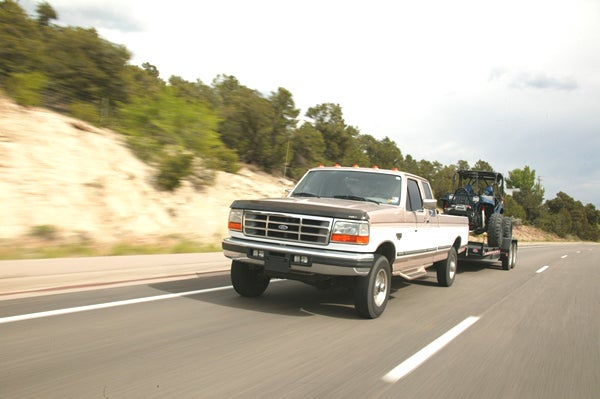
As our vehicles become further modified for rugged terrain, they tend to become single purpose. Tall tires, low gears, and soft suspensions are great on the trail, but they leave something to be desired on the pavement. Add triple digit distances from home to the trail and the increased potential for breakage, a car hauler starts to look like a really good option. The comfort of a tow rig and the potential for increased fuel mileage make the choice a no-brainer. Once you have decided to spring for a car hauler though, the decision making process is far from over. Wood deck or metal? Chains and binders or straps? How heavy of axles do you need? Fortunately Off-Road.com is here to help you sort out all the fine points. We have detailed some of the pros and cons of different trailer options to help make you better informed before you spend your hard earned money on a trailer.
Axle Rating- Not all trailer axles are created equal. Just as a Corporate 14 Bolt offers more beef than a Dana 35, trailer axles are rated for different capacities. Most trailers use axles rated for 3500 pounds each, while heavy duty axles are generally rated for 5200 pounds each. Consider not just the towed vehicle weight when looking at axles, but the weight of the trailer and any additional gear as well. We wouldn’t pull anything heavier than a VW Bug on a small single axle trailer, and would highly suggest upgrading to a 10,000 pound gross weight two axle trailer when it comes time to buy. They don’t cost much more money and you will be thankful for the extra capacity the first time you have to tow home your buddy’s big block powered, Rockwell axled rock buggy or Class 8 truck. Also consider the bolt pattern on the axle’s hubs. 5 x 4 ½ and 5 x 5 ½ are common trailer bolt patterns and may match the pattern on your Jeep or truck.
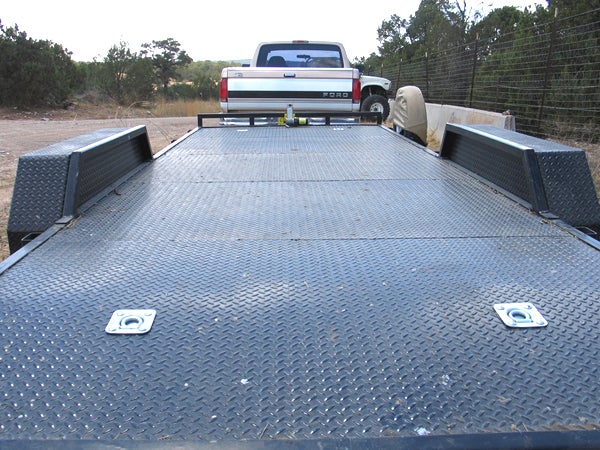 |
A metal deck makes it easy to clean up fluid spills and add tie-down points, and should last the life of the trailer. The downside is that they are more expensive, slightly heavier, and become hot when they sit in the sun all day. |
Wood or Steel Deck- As with everything else, there are compromises to be made on deck material. Wood is lighter and less expensive than steel, however it does not offer the same structural integrity and needs to be replaced more often than a metal deck (or at least sanded, stained, and sealed). While some steel deck trailers offset the weight differences by offering an open deck, which can make repairs to your off-road vehicle easier, they limit the ability of the trailer to be used for other tasks like hauling a car, full sticks of tubing, or a new end mill for your shop. Wooden decks are easy to add fasteners to and don’t heat up as much in the hot sun, but if you are dragging home vehicles from the junkyard that don’t have inflated tires, they are prone to gouging wooden decks. You are less likely to wake the neighbors in the middle of the night if you are using chains to fasten your rig to a wood deck, which is important if you have a bad habit of showing up to camp in the middle of the night.
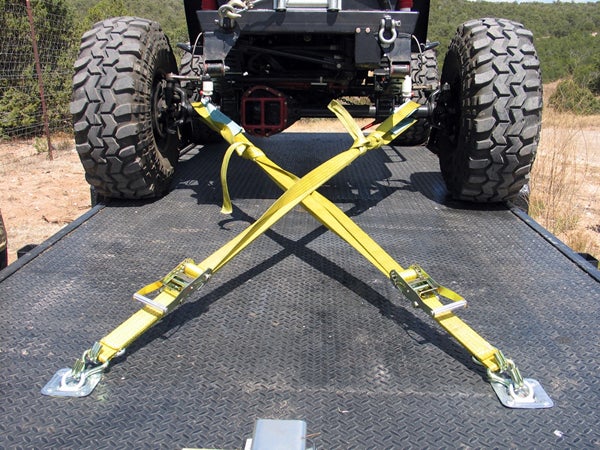 |
These straps were affixed in a cross patter to stabilize the vehicle both lengthwise and side to side as well. Note that the excess strap was tied down instead of being left to flap in the wind and potentially fray. |
Chains or Straps- As mentioned above, chains can be noisy. They are less prone to being cut than straps though and graded chain can be stronger than straps. Chain is typically more expensive (when you add the necessary binders) and more difficult to get the precise length you need than with straps. Some people who tow use a chain on the rear of the trailered vehicle and then tighten the load down with a strap on the front for a combination of convenience and strength. If you are the type of person who wears suspenders and a belt, this might be the choice for you.
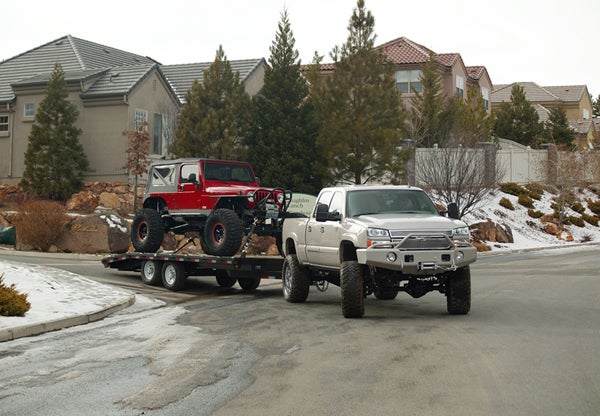 |
The flat deck on this trailer goes over the tires and accommodates even the widest trail rig or buggy. The dovetail makes for easy loading and unloading, but the higher deck height does raise the center of gravity. |
Deck Height- Most trailers have a deck that runs between the wheels with sheetmetal fenders covering the tires. This works fine for transporting cars, but can be problematic for trail rigs, particularly if you are running full width axles or a long travel suspension with longer A arms. One option is to use a deck that runs above the tires, but this significantly raises the center of gravity of your trailer and load. Another option is to reinforce or replace your trailer’s fenders with heavy duty tubing to prevent them from buckling when they are subjected to the weight of your trail vehicle. Redneck Trailer Supplies (yes, really) carries diamond plate fenders that are much stronger than most stock sheetmetal fenders. A less expensive option is to remove the fenders and drive over the tires if the fenders are removable and then replace the fenders for transport.
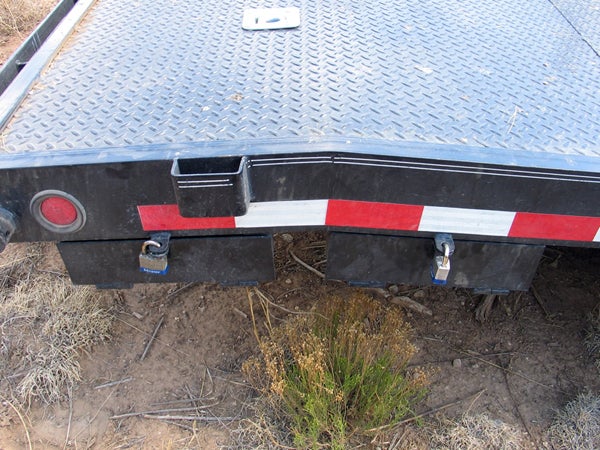 |
Locking your ramps will keep them from disappearing when not in use; just remember where you left the key! |
Dove Tail or Flat- Dove tail trailers cost more than their flat counterparts; however they are easier to load vehicles on and off of. While this might not be an issue for your rockcrawler, if you are transporting a lowered car or truck, the dove tail can make the difference between scraping the frame and clearing the loading ramp. For a lifted vehicle, you may not even need to use ramps to load your rig on a dove tail trailer. The downside is a tendency for the rear of a dove tail trailer to scrape when traveling over uneven terrain like campgrounds and entering or exiting parking lots.
Bumper Pull or Gooseneck- Most of the off-road vehicles we see behind tow rigs are hooked to bumper pull trailers. These leave the bed free for other items, whether it be a cabover camper, ATVs, spare parts, or camping gear. A gooseneck is a good option though if you are pulling a heavy off-road rig or more than one trailered vehicle. The gooseneck mounting method places the tongue weight directly over the rear axle of the truck and allow a tighter turning radius with even less sway than a bumper pull with a load distributing hitch.
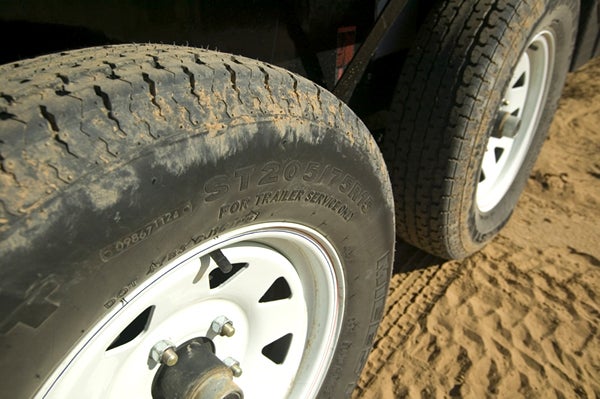 |
Trailers take specific tires that are typically bias ply construction and are made with withstand the unique types of loads that trailers are subjected to. They are not the same as passenger or light truck tires. |
Tires- Most trailer manufacturers go with the lowest bidder when it comes to tires, so there is plenty of room for improvement. Trailer tires have a different set of criteria from normal vehicle tires, since they carry more weight, sit for long periods of time, and scrub around corners. Proper trailer tires are designated Special Trailer (ST) instead of Passenger (P) or Light Truck (LT) and often contain more belts than their passenger car counterparts. Also make sure that the tires are rated for the load you will be carrying. As with axles, it is better to have a margin of safety instead of being loaded to the limit. Regardless of the tires used, make sure that they are properly inflated before each use of your trailer. Just like with off-road vehicles, underinflated tires tend to bulge and create more heat, which can lead to premature failure.
Brakes- Trailer brakes will provide shorter stopping distances than just relying on your tow rig’s brakes, and keep the load straight in a panic situation. As with axles, we recommend upgrading the brakes on your car hauler. Most trailers come with electric drum brakes on one axle, however brakes can be ordered or retrofit on the second axle for a minimal price. Seven inch electric brakes seem to be the most common and are adequate when used on both axles, but 10” electric drums are also an option. Hydraulic brake systems and disc brakes are available, but are considerably more expensive and less common than electric drum brakes.
Frame- Trailers are typically constructed from a combination of box tubing, angle iron, and C channel. Box tubing offers the most torsional strength, however it is also heavier and more expensive than C channel. Consider your budget and use when looking at frame materials and remember heavier is often a good option for bulky trail rigs. Also take note of how far back the tongue of the trailer runs, this can be a good indication of strength and build quality.
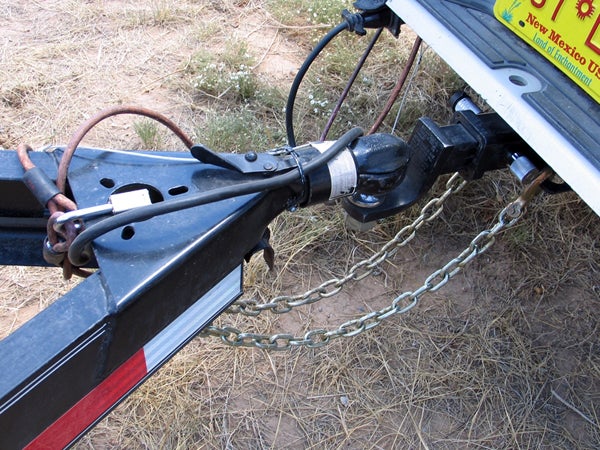 |
This is a Bulldog-style hitch, where the side of the hitch opens up to accept the ball and the collar must slide forward to lock the hitch. Note how these safety chains are the appropriate length and were crossed under the hitch so if it fails the chains will catch the hitch. The wiring is also routed so that it will not become damaged during sharp turns. |
Hitch- The two most common styles of hitches found on car trailers are Fulton and Bulldog couplers. Fulton couplers are less expensive and easy to use. Once the hitch is placed over the ball a latch mechanism secures the hitch to the ball. With Bulldog couplers, the hitch actually opens from the side to accommodate the ball. Once the hitch is on the ball a sliding coupler closes the side of the hitch to completely encase the ball.
Wiring- The electrical wiring in your trailer is not only important, it is also a great indicator of the level of build quality for the rest of the trailer. Butt connectors and exposed wiring are typically indicative of cheap and sloppy quality. Recessed LED lights, wiring ran through a loom or through the frame, and heat shrink tubing are more commonly found on quality built trailers.
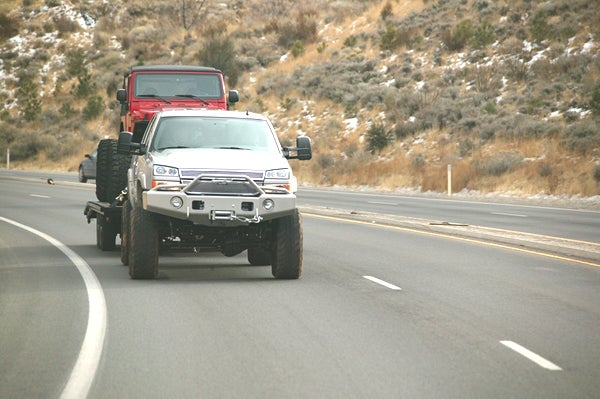 |
A lifted tow rig has its own set of unique concerns, mainly with regards to sway control. Take extra care during high winds and evasive maneuvers if you are driving a lifted tow rig. |
Although there are other factors related to car haulers, the above information should help you make an informed decision when it comes time to buy a car hauler for your off-road vehicle. Knowing what criteria are important to you before you buy will make the process much easier and ensure that you get a trailer that suits your needs. Also remember to consider tongue weight and the abilities of your tow rig once you have made a trailer purchase. Even the best trailer can be difficult to pull if it is strapped to an undersized tow rig with too much or too little tongue weight. We recommend you start with 10-20% of the total trailer weight on the hitch and fine tune from there. Once you realize where this point is, it is wise to note the location of the vehicle on the trailer to aid in loading in the future, and enjoy heading to the dirt with your new trailer.


 Your Privacy Choices
Your Privacy Choices